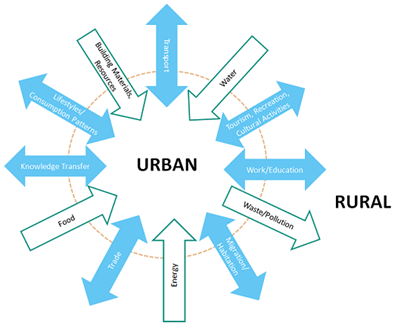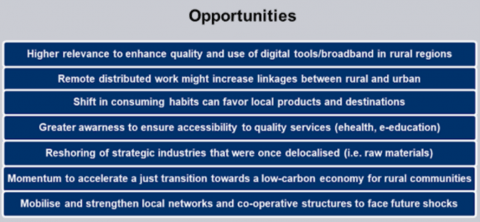Urban-rural innovation linkages

Interreg Europe Policy Learning Platform organised an online discussion on the concept of urban-rural innovation linkages on Tuesday 12 January 2021.
Urban and rural areas have different and often complementary innovation assets. The online discussion explored how better linkages across space (such as flows of people, goods, money, knowledge, and wastes), and linkages between sectors (for example, between agriculture and services and manufacturing) can benefit regional economic development.

Figure 1. Urban-Rural Linkages. Source: Rural Urban Nexus – Global sustainable land use and urbanisation
The concept of urban-rural linkages emerges to respond to the disconnection and dichotomy between rural and urban areas. They tend to be part of different administrative regions with different policy objectives. Policies must therefore develop concepts, instruments, and governance principles, such as urban-rural partnerships, that can address the increasing necessity of integrated planning. Access the introduction presentation.
Andres Sanabria, OECD Regional Development and Tourism Division, presented the OECD findings on urban-rural linkages and COVID19 implications. Since the 2009 financial crisis, regions near metropolitan areas have tended to perform better and build stronger urban-rural linkages compared to remote regions or regions with Small- and Medium-Sized Towns (SMSTs). From the report on policy implications of COVID-19 crisis for rural development, the COVID-19 has shown that rural areas have been more resilient to the COVID-19 shocks. Moreover, Covid-19 has accelerated some trends and opportunities for urban-rural linkages (see figure 2 below).

Figure 2. Opportunities from the COVID-19 crisis for rural areas and linkages. Source: OECD.
Silvia Barbugian Negro, Lombardy Region, presented the good practice Milano Metropoli Rurale, Territorial Development Framework Agreement (AQST), from Interreg Europe RUMORE. Milano Metropoli Rurale AQST is an official agreement for local development focused on strengthening urban-rural linkages going beyond administrative borders and reinforcing traditional rural activities, such as farms’ system and agricultural entrepreneurs, in the wider metropolitan region of Milan.
Some European regions have supported initiatives to connect rural and urban areas. In Next2Met, the project leader, Regional Council of Päijät-Häme (FI), demonstrated the importance of digital networks to enable urban-rural linkages. In CARPE DIGEM, the project leader Digital Nièvre Joint Authority (FR) presented 4 initiatives to foster urban-rural linkages such as Lormes Rural Digital Hub that provides spaces for entrepreneurs and makers in a rural area in France, and 4PDIH – Public, Private, People, Partnership Digital Innovation Hub to diffuse digital technologies and develop local digital capacities.
Marc Pattinson, Thematic Expert in research and innovation, points out that the European Green Deal will offer many opportunities for strengthening urban-rural linkages whether it is the resource dimension or capacity-building to promote regional circular ecosystems. New enabling conditions within the 2021-2027 S3 strategy development process also highlight the need to better address the issues that result in geographical disparities of growth across regions.
Policy Learning Platform resources
- Read the policy brief on
- Read the story on how to foster collaborative spaces in rural areas
- Read the news on the European Green Deal
If you have any specific questions related to urban-rural innovation linkages, you can reach out to Policy Learning Platform experts directly via the policy helpdesk.